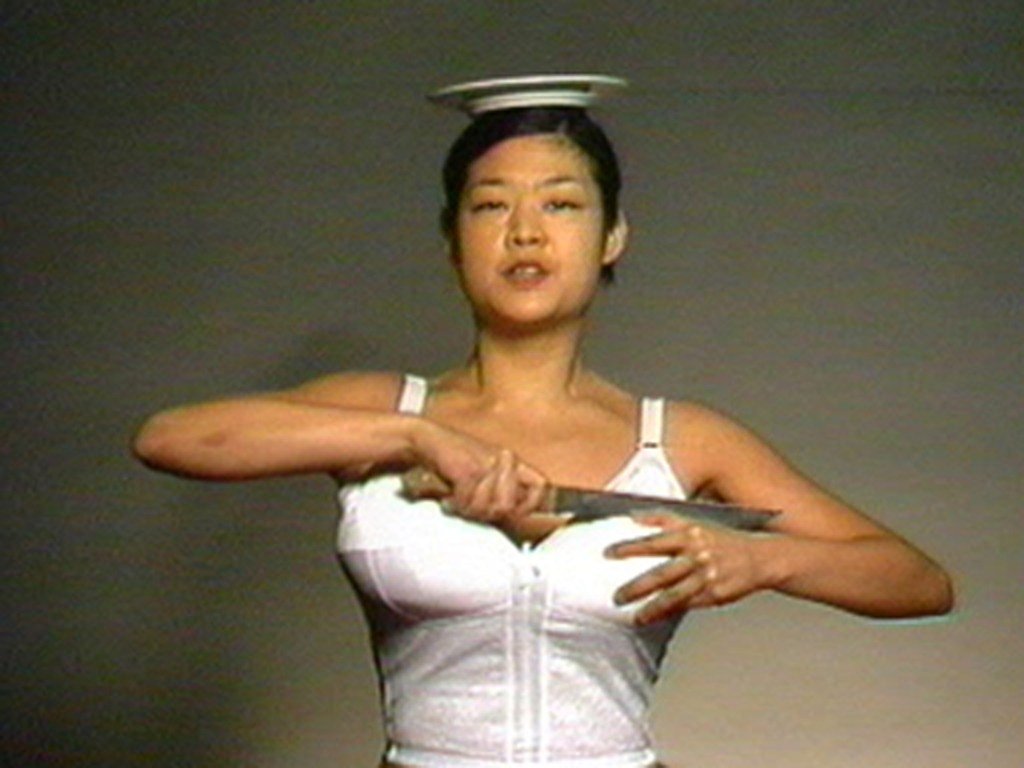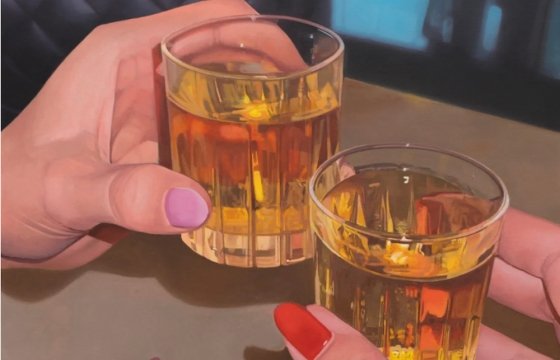

Is this she or it, what with those
empty bowls and vases miming hips
and those self-interrupting
lines acting
as gestures or broken speech?
Are we bearing witness
to organic remains or synthetic creations,
feral proliferation or arrested development?
—Anne Anlin Cheng, “The Stranded Beauty of Yeesookyung,” in Monstrous Beauty: A Feminist Revision of Chinoiserie (2025)
The exotic, objectified Asian woman is one of the oldest, most proliferate, and least examined (in)human figures to emerge out of centuries of European cultural imagination about the Eastern Other. And chinoiserie, a stylized rendition of Chinese people, culture, and aesthetics cultivated by early 18th-century European decorative arts, has long been considered a minor, even denigrated, aesthetic category, associated with feminine frivolity and artificiality, a decadent superficiality that has come to be symbolized by Asiatic femininity itself. Yet, despite the charges of cultural appropriation and racist projection, both the trope of the exotic Asian woman and chinoiserie continue to thrive in contemporary life and culture. As recently as 2015, the Metropolitan Museum of Art mounted its own sumptuous, Orientalist sensorium in the enormously popular exhibition China: Through the Looking Glass, which explicitly celebrated the fantasy of China as “a land of free-floating symbols.” Yes, chinoiserie is very much alive.

So when Iris Moon, associate curator of European Sculpture and Decorative Arts at The Met, contacted me in 2022 about the possibility of collaborating on an exhibition that revisits European chinoiserie, I was wary. Is this one of those invitations to act as the academic “beard” for yet another exploitative show in the guise of “revision”? And even if the curator had a genuinely critical vision in mind, would an institution like The Met allow it?
The minute I met Moon, I knew I was in safe hands. Alongside Lesley Ma and Eleanor Hyun, she is one of a small group of Asian-American women curators in different departments of The Met redefining the museum’s role as caretaker of cultural memory by introducing new approaches to contemporary and historical works of art. She is also most recently author of Melancholy Wedgwood (2014), a smart and experimental biography of Josiah Wedgwood that traces the postcolonial and transglobal afterlives of porcelain.
It therefore comes as no surprise that Monstrous Beauty: A Feminist Revision of Chinoiserie emerged as this expansive, profound, and at times wry meditation on the interchange between style, racialized femininity, global commodity, beauty, violence, private desires, and national ambitions. Underpinning the exhibition is the implicit question: How does something as superficial as style become the foundation for imagining human value and embodiment?
Everything about this show is challenging and quirky — from the mesmerizing dialogue it constructs between 18th-century European objects and contemporary Asian-American women artists speaking to that history and its impact on their lives, to the audio tour that is less a guide and more like a conversation among friends who just happen to know something about the subject. Even the “classical” objects chosen for the exhibition that should be reified as dusty exemplars of Euro-American colonial history emit a strange and unruly animacy that reminds us that objects have wayward lives, even if their creators and traders controlled their production and circulation.

Consider this 17th-century artifact, labeled “Porcelain and Pepper.” It is a stranded piece of a ship, probably iron, recovered in 1976 from the bottom of the ocean. It was part of the shipwreck of the Witte Leeuw, or White Lion, a three-masted ship owned by the Dutch East India Company that was carrying 400 kilograms (~881 lb) of porcelain, one of the most sought-after treasures of the time, and a cargo of spices, probably even more precious then. Pieces of china and peppercorn have embedded themselves into the fragment over time, even as marine life and organisms made homes out of this otherworldly remnant. This broken “branch,” this “monstrous body born from the greed for the artificial white substance that would feed European trade for centuries,” as Moon puts it in her catalog essay, offers us a fragment of a rooting genealogy and a repository of both imperial history and its wreckage.
Indeed, this simultaneously organic and artificial “body” is memory. It instantiates the fragmented residue of voracious imperial appetite — but it also embodies a strange form of survivance, suggesting that things can bear meanings promiscuous to their origins as commodity. This is historical sedimentation that carries its own internal critique.
Other uncanny objects in this exhibition offer multiple and unexpected narratives as well. Instead of seeing White European women’s relationship to porcelain as simply an instance of female vanity and “fatal excess,” as Daniel Defoe put it in A Tour Through the Whole Island of Great Britain (1724), Monstrous Beauty tells the fascinating story of how Mary II, queen of England, consort of William III, and the person thought to have birthed the European taste for chinoiserie, deployed her considerable “china wear” collection as a kind of sartorial, psychical prosthetic — as an extension of her sovereignty, and as a symbolic replacement for her infertility. In short, a story of how Mary II created through her “porcelain bodies” a maternal lineage for the House of Orange. Her complex relationships to her ceramic “progeny” remind us that monstrosity is really simply human entanglement with the other-than-human.
These wobbly and uncertain objects, which speak from the depths of history, are paired with artworks by contemporary Asian-American artists that respond with their own unstable presences. Walking through the deep galleries of European Sculpture and Decorative Arts in order to reach the stairs down into the lower Robert Lehman Wing, where the exhibition is housed, one feels like Persephone descending into Hades’s underworld, if his realm were in fact a female-dominated, glittering landscape of nonliving things teeming with life. One is greeted first by an arresting ceramic “forest” featuring artist and sculptor Yeesookyung’s ceramic assemblages.
There’s magic here, and there’s grief. There’s stillness, but also vibrancy and proliferation — a strange life indeed. Somewhere between a petrified crypt and an enchanted forest, each of Yeesookyung’s broken, resuscitated piece of ceramic operates as a self-forming agent that appears to be generating an infinite expansion toward an unexpected fabrication, an assemblage of fictitious loquacity and stuttering discards. Her works suggest not only that art and waste, the human and the inhuman, can co-exist, but also that these oppositions may be profoundly, materially, and imaginatively indebted to one another. The idea of women as vase and vessel is of course a very old one, and the comparison between the Asian woman and the vase is even older. But here the decorative vessel has become at once more artful and more resistant, more broken yet also newly formed.

We turn and are then confronted by Lee Bul’s larger-than-life, shining, encrusted sculpture-cum-creature. “Monster: Black” (1998/2011) (as if the color itself were its name), part of a larger series, appears grotesque, asymmetrical, blobby, full of flesh-like limbs, tendrils, and exposed organs that are explosively congealed, yet also morphing. Crafted from materials often used for women’s ornaments, including metal, silicone, resin, chains, crystal beads, and organic matter, Lee’s monster dramatizes the complicity between the organic and the inorganic, between art and waste. It, too, straddles the ambivalence between life and nonlife: Its tendrils are hardened, yet also suggestive of growth, fullness, animacy, a bursting out of life, a fermentation that is also an arrest.
Then there’s Patty Chang’s heart-stopping short video “Melons (At a Loss)” (1998), where female inheritance (in the form of a porcelain plate bequeathed by her aunt, placed precariously on her head), self-mutilation, and self-nourishment/feeding all converge with queasy ease. Is it a coincidence that Asian-American women artists today are meditating on what Moon calls the “porcelain imaginary” and what I have elsewhere called “ornamentalism” — that conflation between Asiatic femininity and ornament, that at times coercive but also at times transformative, transitive property between persons and things? I think not. The question of personhood, corporeal embodiment, and their erasures has been a central crisis and the condition for the making of Asiatic womanhood in Western cultures for centuries.
Another piece by Chang, commissioned by The Met, both concludes and begins the circular show. A ceramic sculpture made in the shape of a massage table, it explicitly references the 2021 brutal shooting of six Asian-American women in Atlanta, underscoring the manual labor and precarity that shaped these women’s lives. The “bed” of this massage table is unfinished ceramic, its porous “skin” allowing for dirt and moisture over time to stain its surface. The bed is also punctured with several random holes, the edges of which have been sanded razor-thin. These frail borders are unexpectedly poignant, for they underscore the fragility of this table that was meant to support a body.
Chang’s intention, after the end of the exhibition, is to sink the sculpture into the Pacific, at the site of a former Chinese community on the California coast that was burned out by a White riot in the 19th century at the height of anti-Asian sentiment. Here is an art that refuses to be hoarded as treasure. This is a different kind of shipwreck — an intentional one, but one that also invokes the centuries-long entanglement between Western desire and Asiatic “goods,” both material and corporeal, from ceramic to spices to human labor. Chang’s ceramic memorial, though, aims to transform waste into birth, as it is meant, once sunken, to become a substrate for coral growth, to breed new, inhuman life.

From Marco Polo in the 13th century confusing Chinese women with the ornaments that they wore to 18th- and 19th-century chinoiserie to contemporary iterations of the “exotic Asian woman” from science fiction to pornography, there has been a longue durée of conflating Asiatic femininity with artificiality, pure sensorium, style, and aesthetic thingliness. And to this centuries-long, ongoing process of de-personing and objectification, we have very little to say except the reiteration of a mostly ineffectual moralism. But authenticity (“we aren’t really like that”) has never been an adequate antidote, because it produces its own sets of stereotypes, running the danger of reasserting essentialist claims (“we are really like this”). And what can authenticity mean anyway for a “subject” made (and unmade) through artifice?
It would be a mistake and a terrible reduction to say that Monstrous Beauty offers a feminist or racial corrective to a show like 2015’s China: Through the Looking Glass, because as I have argued extensively elsewhere, to dismiss the latter as mere Orientalism is to silence yet again those objects consigned to display. When we pay attention, history’s captured objects have much to say. In recent years, museums have increasingly been accused of being repositories of colonial rapaciousness. But they are also guardians of historical memory and architects of how that past continues to shape our present, which is especially important given the willful forgetfulness of our current moment. The exhibition China: Through the Looking Glass may have rehearsed for the 21st-century audience the basic tenets of 19th-century Orientalism, but the objects within its purview insisted on their own historicity, their materiality counterintuitively bearing witness to and documenting the fraught, multiple, and mediated histories of transglobal desire and denigration. In China: Through the Looking Glass, beyond what their Euro-American makers and users might have intended or silenced, silk and porcelain have their own stories to tell.

Monstrous Beauty makes explicit these marginal, unheard narratives behind the lives of objects. This exhibition “about” 18th-century chinoiserie takes risks: By choosing some of the more uncanny and disturbing objects, by inserting a living relationship with contemporary art and social issues, by rethinking the vectors and terms of feminism. It highlights the perilous intimacy between our cherished notions of personhood and objets d’art: What does it mean to be a human ornament? Who or what can count as a person? What kind of life counts? What is “woman” if her fleshly embodiment resides in aesthetic abstraction? What does it mean to survive as an object?
When Moon leads us into the show on chinoiserie by way of Yeesookyung’s collated fragments; when she puts Chang’s video “Melon (At a Loss)” next to a 18th-century silver toilet service with tea cups offered as a gift to a woman after her wedding night; when she juxtaposes John Bowles’s 18th-century print “The Tea-Table” with Candice Lin’s satirical answer, which links the refined table to the labor behind it; and when she poses the fragment of a 16th-century shipwreck and Chang’s unfinished “Abyssal: Massage Table” — itself also destined to become stranded wreckage at the bottom of the Pacific — as the two ending or beginning points in the circular galleries, Moon telescopes the past and the present, revealing their continuities and, in doing so, reconfiguring both. She questions citationality itself and what it means to re-visit. What’s at stake is the question of approach: How do we approach a vast history that has produced, and continues to produce, a great deal of beauty, profit, and violence? What is our relationship to objectification, its jeopardy and pleasure, and can we be open to not only our complicity in that seduction but also to how a material life might be speaking to us — mutely, insistently?
To find beauty in the cracks
is to know transformation
where there is nowhere else to go…This is how we talk about beauty
in a broken world.


